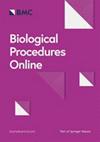A novel method to efficiently differentiate human osteoclasts from blood-derived monocytes
IF 4.3
3区 生物学
Q1 BIOCHEMICAL RESEARCH METHODS
引用次数: 0
Abstract
Osteoclasts are the tissue-specific macrophage population of the bone and unique in their bone-resorbing activity. Hence, they are fundamental for bone physiology in health and disease. However, efficient protocols for the isolation and study of primary human osteoclasts are scarce. In this study, we aimed to establish a protocol, which enables the efficient differentiation of functional human osteoclasts from monocytes. Human monocytes were isolated through a double-density gradient from donor blood. Compared to standard differentiation schemes in polystyrene cell culture dishes, the yield of multinuclear osteoclasts was significantly increased upon initial differentiation of monocytes to macrophages in fluorinated ethylene propylene (FEP) Teflon bags. This initial differentiation phase was then followed by the development of terminal osteoclasts by addition of Receptor Activator of NF-κB Ligand (RANKL). High concentrations of RANKL and Macrophage colony-stimulating factor (M-CSF) as well as an intermediate cell density further supported efficient cell differentiation. The generated cells were highly positive for CD45, CD14 as well as the osteoclast markers CD51/ITGAV and Cathepsin K/CTSK, thus identifying them as osteoclasts. The bone resorption of the osteoclasts was significantly increased when the cells were differentiated from macrophages derived from Teflon bags compared to macrophages derived from conventional cell culture plates. Our study has established a novel protocol for the isolation of primary human osteoclasts that improves osteoclastogenesis in comparison to the conventionally used cultivation approach.从血源性单核细胞高效分化人类破骨细胞的新方法
破骨细胞是骨组织特异性巨噬细胞群,具有独特的骨吸收活性。因此,它们是健康和疾病中骨生理的基础。然而,用于分离和研究原代人类破骨细胞的有效方案却很少。在这项研究中,我们的目标是建立一种方案,能够从单核细胞中有效分化出功能性人类破骨细胞。通过双密度梯度从供体血液中分离出人类单核细胞。与在聚苯乙烯细胞培养皿中的标准分化方案相比,在氟化乙烯丙烯(FEP)聚四氟乙烯袋中将单核细胞初步分化为巨噬细胞后,多核破骨细胞的产量显著增加。在初始分化阶段之后,加入 NF-κB 受体激活剂配体(RANKL),就能形成末端破骨细胞。高浓度的 RANKL 和巨噬细胞集落刺激因子(M-CSF)以及中等细胞密度进一步支持了细胞的高效分化。生成的细胞对 CD45、CD14 以及破骨细胞标记 CD51/ITGAV 和 Cathepsin K/CTSK 呈高度阳性,因此可将它们鉴定为破骨细胞。与从传统细胞培养板中提取的巨噬细胞相比,从特氟隆袋中提取的巨噬细胞分化出的破骨细胞的骨吸收率明显提高。我们的研究为分离原代人类破骨细胞建立了一种新的方案,与传统的培养方法相比,它能改善破骨细胞的生成。
本文章由计算机程序翻译,如有差异,请以英文原文为准。
求助全文
约1分钟内获得全文
求助全文
来源期刊

Biological Procedures Online
生物-生化研究方法
CiteScore
10.50
自引率
0.00%
发文量
16
审稿时长
>12 weeks
期刊介绍:
iological Procedures Online publishes articles that improve access to techniques and methods in the medical and biological sciences.
We are also interested in short but important research discoveries, such as new animal disease models.
Topics of interest include, but are not limited to:
Reports of new research techniques and applications of existing techniques
Technical analyses of research techniques and published reports
Validity analyses of research methods and approaches to judging the validity of research reports
Application of common research methods
Reviews of existing techniques
Novel/important product information
Biological Procedures Online places emphasis on multidisciplinary approaches that integrate methodologies from medicine, biology, chemistry, imaging, engineering, bioinformatics, computer science, and systems analysis.
 求助内容:
求助内容: 应助结果提醒方式:
应助结果提醒方式:


